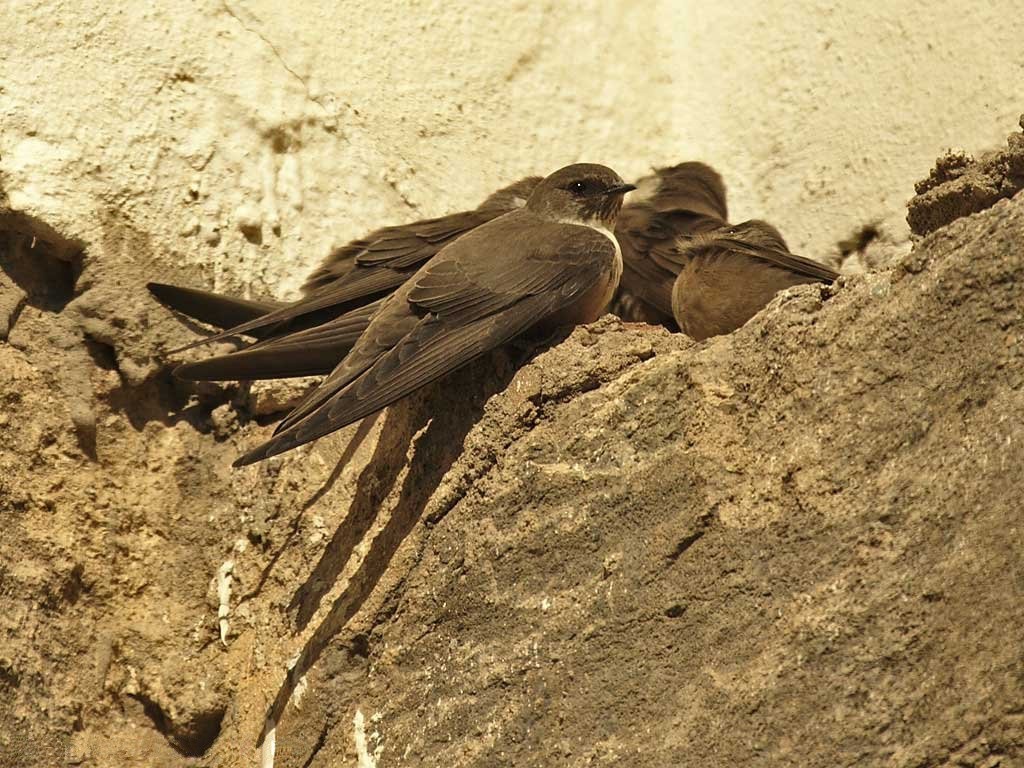Eurasian Crag Martin
A species of Crag Martins Scientific name : Ptyonoprogne rupestris Genus : Crag Martins
Eurasian Crag Martin, A species of Crag Martins
Botanical name: Ptyonoprogne rupestris
Genus: Crag Martins
Content
Description People often ask General Info
Description
The Eurasian crag martin is 13–15 cm (5.1–5.9 in) long with a 32–34.5 cm (12.6–13.6 in) wingspan, and weighs an average 23 g (0.81 oz). It has ash-brown upperparts and paler underparts, and has a broader body, wings and tail than any other European swallow. The tail is short and square, with white patches near the tips of all but the central and outermost pairs of feathers. The underwing and undertail coverts are blackish, the eyes are brown, the small bill is mainly black, and the legs are brownish-pink. The sexes are alike, but juveniles have buff-brown tips to the plumage of the head, upperparts and wing coverts. This species can be distinguished from the sand martin by its larger size, the white patches on the tail, and its lack of a brown breast band. Where the range overlaps with that of another Ptyonoprogne species, the Eurasian crag martin is darker, browner and 15% larger than the rock martin, and larger and paler, particularly on its underparts than the dusky crag martin. The white tail spots of the Eurasian crag martin are significantly larger than those of both its relatives. The crag martin's flight appears relatively slow for a swallow. Rapid wing beats are interspersed with flat-winged glides, and its long flexible primaries give it the agility to manoeuvre near cliff faces. The average migration flight speed has been measured at 9.9 m/s (32.5 ft/s), less than the roughly 11 m/s (36 ft/s) typical for hirundines, but the data is limited. The bird often flies high, and shows the white spots as it spreads its tail. The vocalisations include short high pli, and piieh and tshir calls resembling those of the linnet and the house martin respectively. 
Size
15 cm
Colors
Brown
Gray
White
Nest Placement
Cliff
Feeding Habits
Eurasian Crag Martin predominantly catches insects mid-flight, often near rock faces or above water surfaces. Their insectivorous diet varies with availability, including flies, ants, spiders, and beetles, with some localization in preferred prey types. Eurasian Crag Martin remains close to breeding areas for feeding, forming flocks in non-breeding seasons where food is plentiful. They display highly maneuverable flight adapted for exploiting insect-dense areas near cliffs.
Habitat
Eurasian Crag Martin's habitats are predominantly in mountainous areas with cliffs and gorges, suitable for breeding in dry, warm, and sheltered conditions. They inhabit regions from southern Europe to parts of Africa, the Persian Gulf, the Himalayas, and parts of China. Typically residing at altitudes between 2,000 to 2,700 meters, some populations breed as high as 5,000 meters in Central Asia. Eurasian Crag Martin seeks areas with sufficient insects for feeding, and may inhabit lower altitudes, including diverse landscapes and human vicinities during non-breeding periods.
Dite type
Insectivorous
People often ask
General Info
Feeding Habits
Bird food type
Sounds
Call
Recording location: France
Call
Recording location: France
Distribution Area
The Eurasian crag martin breeds in mountains from Iberia and northwesternmost Africa through southern Europe, the Persian Gulf and the Himalayas to southwestern and northeastern China. Northern populations are migratory, with European birds wintering in north Africa, Senegal, Ethiopia and the Nile Valley, and Asian breeders going to southern China, the Indian subcontinent and the Middle East. Some European birds stay north of the Mediterranean, and, like martins in warmer areas such as India, Turkey and Cyprus, just move to lower ground after breeding. The breeding range is bounded by the 20 °C (68 °F) July isotherm, and wintering areas need a temperature of about 15 °C (59 °F) for enough insect food to be available. This is a rare species any distance north of its breeding areas. For example, there are only eight records from the UK, none from Ireland, and the first record for Sweden was reported as recently as 1996. South of its normal wintering range, it has occurred as a vagrant in The Gambia. Crag martins breed on dry, warm and sheltered cliffs in mountainous areas with crags and gorges. The typical altitude is 2,000–2,700 m (6,600–8,900 ft) but breeding occurs up to 5,000 m (16,000 ft) in Central Asia. The Eurasian crag martin's choice of nest sites is very similar to that of Savi's pipistrelle, Hypsugo savii; the bird and the bat often breed in the same locations and have almost identical ranges in Europe. In South Asia, migrant Eurasian birds sometimes join with flocks of the dusky crag martin and roost communally on ledges of cliffs or buildings. 
Species Status
Not globally threatened.
Scientific Classification
Phylum
Chordates Class
Birds Order
Perching birds Family
Swallows Genus
Crag Martins Species
Eurasian Crag Martin 